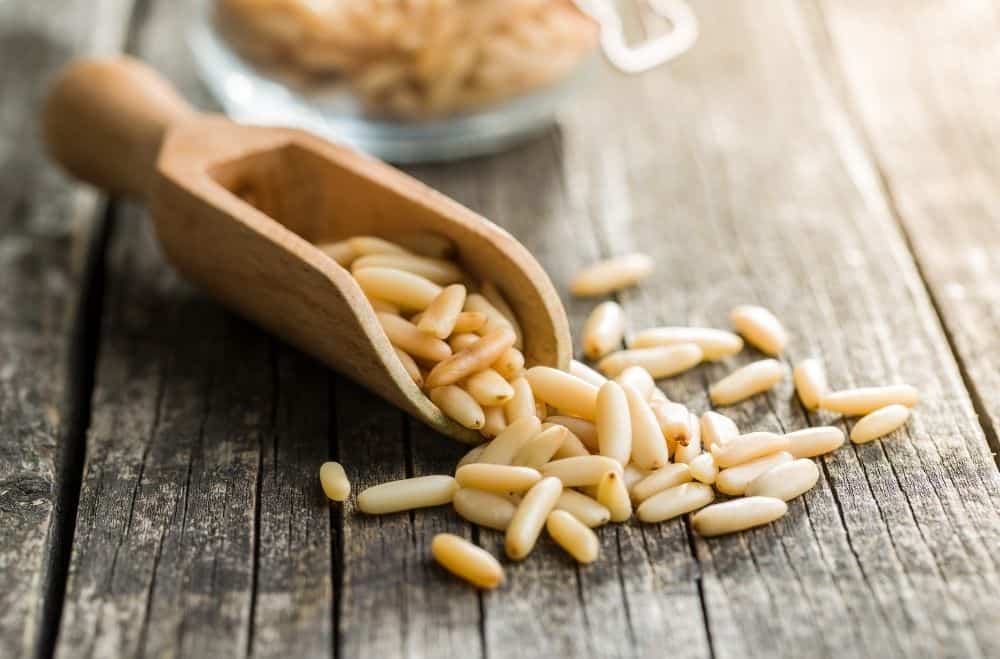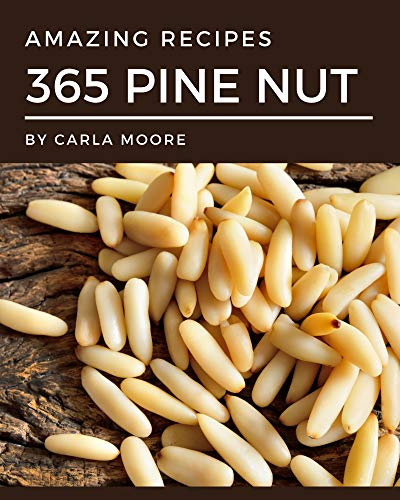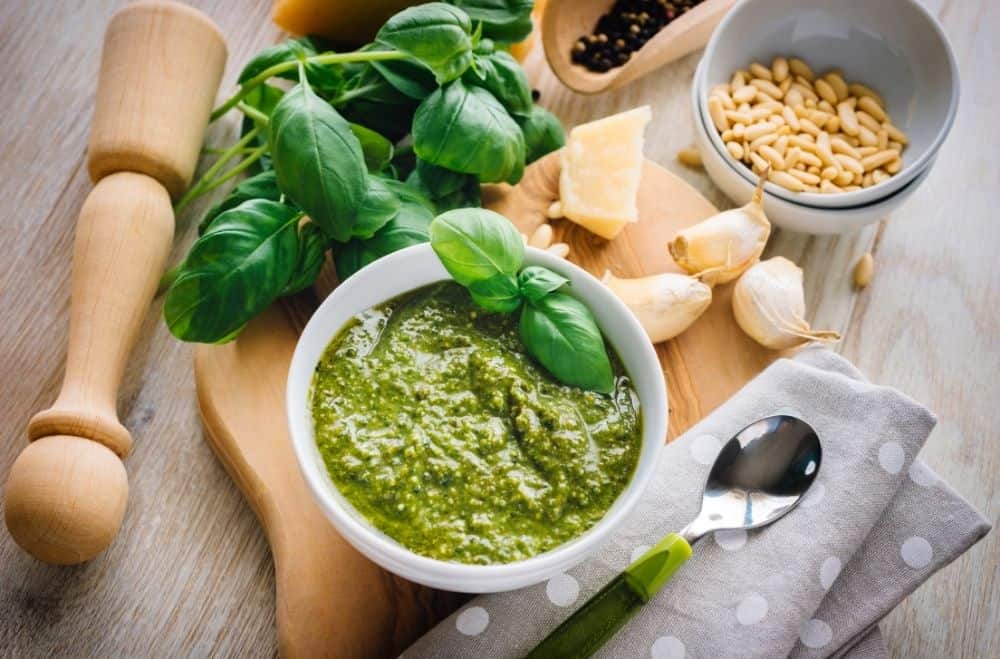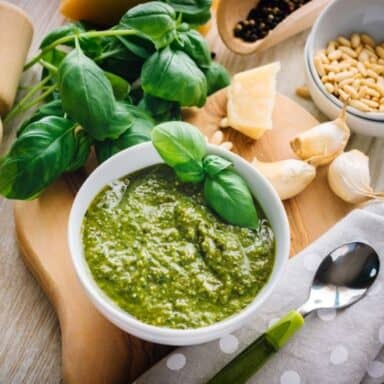
For those of you who have not tried pine nuts or simply think they are some kind of earthy-crunchy food, you may want to rethink that notion. They are very healthy, can be eaten raw, toasted, on salads, and in pasta, and are very popular in Mediterranean recipes. They are also very popular in Europe, particularly in Italy, where the nut is used in the classic preparation of basil pesto as well as in popular pignoli cookies.
What Exactly is a Pine Nut?
Pine nuts are small, oval seeds in a pale white or cream color. The biggest variety may reach about 1/2 inch long. The raw seeds have a soft texture and a sweet, buttery flavor.
They are often called nuts because of their nutty, buttery flavor and crunchy texture. They may also be called pignoli, depending on where you find them.
Where Do Pine Nuts Come From?
Pine nuts come from pine trees. To be more accurate, they come from pine cones and they are not actually nuts but an edible seed. The seeds are the inner, edible part of the nut casing, which is very hard and not edible.
There are about 20 different types of pine trees that are able to produce nuts that are large enough to harvest. The most commonly used seeds or nuts are harvested from four main pine tree varieties. Those are the Pinus cembroides-Mexican pinon, the Pinus edulis-Colorado Pinyon Pine, Pinus pinea-the Italian stone pine, and the pinus armandii – Chinese pine nut tree.
These pine trees that are best at producing usable pine nuts or seeds can be found throughout the world. Climates that are best for pine trees include China, Russia, Mongolia, Korea, and Afghanistan.
Pine Nut Harvesting
Part of the reason pine nuts are so expensive is that they take a long time to reach maturity. They are difficult to harvest, being so small, they are hard to get out of the pine cone, and it requires quite a few to use for most recipes.
The pine nuts take about a year and a half to become ripe and reach maturity, but some varieties that are grown in more challenging weather conditions may take up to twice that amount of time.
When they are finally ripe, harvesters must gather the pine cones, break them open, and separate the nuts from the pine cone fragments by hand. This requires patience and attention to detail.
Pine nuts have a thick second shell that must be removed, as well, before the seeds are ready for roasting or eating. Depending on the pine cone, this second coating can be difficult to remove.
The long growing time, the gathering and waiting for the pine cones to dry, and the time and effort needed to remove the seeds from the pine cone are why the seeds can be quite expensive.
Pine Nut Mouth and Allergies
Just like other nuts and seeds, people can have allergies or a negative reaction to eating them. Called “pine nut mouth” or “pine nut syndrome,” can happen when you eat pine nuts but it causes the other food you consume to have a metallic, bitter taste.
However, this issue seems to only last a few days and is thought to be caused by a few very specific species of pine trees mainly found in China. A pine nut allergy is a lot less common than allergies from other tree nuts.
10 Surprising Health Benefits of Pine Nuts

Pine nuts not only have a truly unique flavor, but they are also powerful health agents. They are very nutritious and a good source of thiamine (B1), Vitamin K, magnesium, protein, and healthy fats. They are also one of the best natural sources of manganese, phosphorus, and zinc.
Here are 10 more reasons to incorporate them into your diet.
1. They boost your energy levels.
If you need a fantastic, healthy midday pick-me-up to face your daily challenges, look no further. Pine nuts can prevent fatigue and burnout by giving you an energy boost thanks to their iron, magnesium, and healthy fats. Iron, in particular, is a beneficial essential mineral because it helps transport and store energy throughout the body, and it can counter the symptoms of fatigue and tiredness. It also regenerates body tissues and helps cells utilize available energy more efficiently.
2. They encourage weight loss.
Pine nuts can help you shed those extra pounds by promoting cholecystokinin production. This hormone suppresses appetite by signaling to the brain that you are not hungry anymore. Pine nuts can also help you lose weight thanks to another special chemical compound, pinolenic acid, which increases satiety and helps you stay full for longer. Studies indicate that consuming these tiny nuts before meals can help you decrease your food intake and eat smaller portions. Finally, pine helps you burn belly fat and, consequently, reach your weight loss goals faster.
3. They are suitable for people with diabetes.
This unusual but all-natural food can benefit people with type 2 diabetes. Moderate consumption of pine nuts contributes to better control over glucose and cholesterol levels. They are also a great snack option for everybody since they increase insulin sensitivity. What’s more, adding pine nuts to your meals, for instance, sprinkling a handful over a stir-fry, reduces the overall glycemic index of the foods you consume.
4. They improve cardiovascular health.
Pine nuts are full of heart-friendly nutrients: from monounsaturated fats, minerals (manganese, magnesium), and vitamins (E, K) to plant sterols, they contain everything you need for healthy blood flow and keeping your arteries in top shape. Studies indicate that eating pine nuts reduces the risk of heart disease as well as the risk of sudden cardiac death. Moreover, oleic acid, another compound found in pine, reduces LDL cholesterol while increasing HDL cholesterol (which is the good kind).
5. They can keep your brain happy.
They are a superb source of iron, a mineral necessary for brain oxygenation. These tiny delights are also rich in magnesium, which has many implications for proper brain function and psychological health. Studies have found that the magnesium in pine lowers stress, anxiety, and depression while protecting from various emotional disorders. They also improve sleep and memory. In other words, eating pine nuts frequently can make you feel happier!
6. They promote bone health.
When thinking about bone health, getting enough calcium is the first thing that comes to mind. However, calcium isn’t the only essential nutrient for your bones; many vitamins and minerals play crucial roles in maintaining bone integrity. Pine nuts are a decent source of vitamin K. This nutrient improves bone density and protects against fractures while preventing conditions such as osteoporosis.
7. They enhance immunity.
Pine nuts contain many nutrients that give your immune system a healthy boost: zinc and manganese protect your body against harmful bacteria and free radicals. They also strengthen connective tissues and balance hormones. Other minerals, such as potassium and selenium, help the body resist infectious agents and viruses.
8. They keep your eyes sharp.
Pine nuts are a source of lutein, a carotenoid vitamin, and a potent antioxidant that improves your eyesight. Lutein has been studied for its ability to prevent macular degeneration and the formation of cataracts. This carotenoid also protects the macula (central part of the eye retina) from UV light damage. On top of that, pine nuts contain vitamin A, another essential nutrient for healthy vision.
9. Pine nuts can do wonders for your skin and hair.
Undoubtedly, a healthy diet can improve the condition of your skin even more than your daily skincare routine. Pine nuts are a great source of antioxidants that slow down the process of aging by protecting your DNA from free radical damage. In addition, their vitamin and mineral content promotes a healthy scalp, nourishes your hair follicles, and can even reduce hair loss.
10. They are completely gluten-free.
These amazing little seeds can be a useful ingredient for all the gluten-conscious people out there. They are a great addition to your gluten-free recipes and a recommended food for those who have a wheat allergy or celiac disease. They can also be useful if you want to reduce your gluten intake.
How to Toast Pine Nuts

If you buy your pine nuts raw, you may actually find them a bit cheaper, and then you can toast them yourself to use as a snack or in your favorite recipes. The heat releases and intensifies the rich nutty, buttery flavor of pine nuts.
Here are three ways to toast roast pine nuts.
1. In The Oven
Spread the nuts on a baking sheet and bake at 375°F, stirring occasionally, until golden brown, 5 to 10 minutes. The color of oven-toasted nuts is evenly golden. Be sure to keep an eye on them the entire time, as they can become too hot, and they will burn rather quickly.
2. Toaster Oven
Your toaster oven will work very well and not use as much energy as heating up the entire oven will.
Spread the nuts on a small baking sheet and bake at 325°F, stirring regularly so they don’t burn. This should only take about 3 to 5 minutes. Again, you want to keep an eye on them as the heating elements will be much closer to the pine nuts, and you do not want them to get burnt.
3. Stove Top
The easiest way to toast pine nuts is on the stove. Spread them out in a single layer in a dry frying pan. It doesn’t really matter what kind of pan you use, just don’t let them burn.
Toast them on medium-low, stirring or tossing them in the pan, until they’re golden brown and have a rich nutty aroma. Don’t leave them cooking on their own, as they will burn in a few seconds flat.
It should only take about 3 to 5 minutes to toast. Once they are finished, put them on something to cool so they don’t continue toasting in the hot pan.
Get Creative When Toasting
You can always get creative when you toast your pine seeds. Add a bit of olive oil, salt, vinegar, curry or turmeric, hot mustard, or other types of savory seasonings.
You can also add honey, sugar, melted chocolate, or think about flavored extracts. If you plan on using them in a baking recipe, or in chocolates, add a few different flavorings, like mint, cherry, or others that you like.
Storing Your Pine Nuts
Keep in mind that toasted pine nuts can turn rancid much more quickly than raw ones, so you’ll want to use them up within one week.
Raw pine nuts should be kept in an airtight container in the refrigerator for one to two months. If you wish to extend their shelf-life, place them in a heavy-duty freezer bag in the freezer for up to six months. If your pine nuts have turned rancid, they will give off an unpleasant odor and often develop a bitter taste. They may also develop mold.
Where to Buy Pine Nuts

You can buy pine nuts raw or already toasted in specialty shops, health food stores, larger supermarkets, and of course, on Amazon. Buy them and use them often. They are healthy, versatile, and easy to cook with. Eat a fresh pine nut by itself, or add them to a favorite recipe like this pesto recipe below. Enjoy!
How to Make Pesto Sauce with Pine Nuts
.

Pesto Sauce
Ingredients
- 2 cups fresh basil leaves
- 1/2 cup freshly grated Romano or Parmesan-Reggiano cheese about 2 ounces
- 1/2 cup extra virgin olive oil
- 1/3 cup pine nuts
- 3 garlic cloves minced
- 1/4 teaspoon salt more to taste
- 1/8 teaspoon freshly ground black pepper more to taste
- Juice of one lemon or lime if desired
Instructions
- Place the basil leaves, pine nuts, and citrus juice into the bowl of a food processor and pulse several times to blend.
- Add the garlic and Parmesan or Romano cheese and pulse several times more. Scrape down the sides of the food processor with a rubber spatula or wooden spoon to make sure it is all getting evenly blended.
- While the food processor is running, slowly add the olive oil in a steady small stream. Adding the olive oil slowly, while the processor is running, will help it emulsify and will help to keep the olive oil from separating. Stop when needed to scrape down the sides of the food processor and make sure it is all blended evenly.
- Stir in salt and freshly ground black pepper, add more to taste.
- You can use your pesto on pasta, on bread, on baked potatoes, as a dip with vegetables, add it to other sauces, casserole, and stews, or any way you like.
